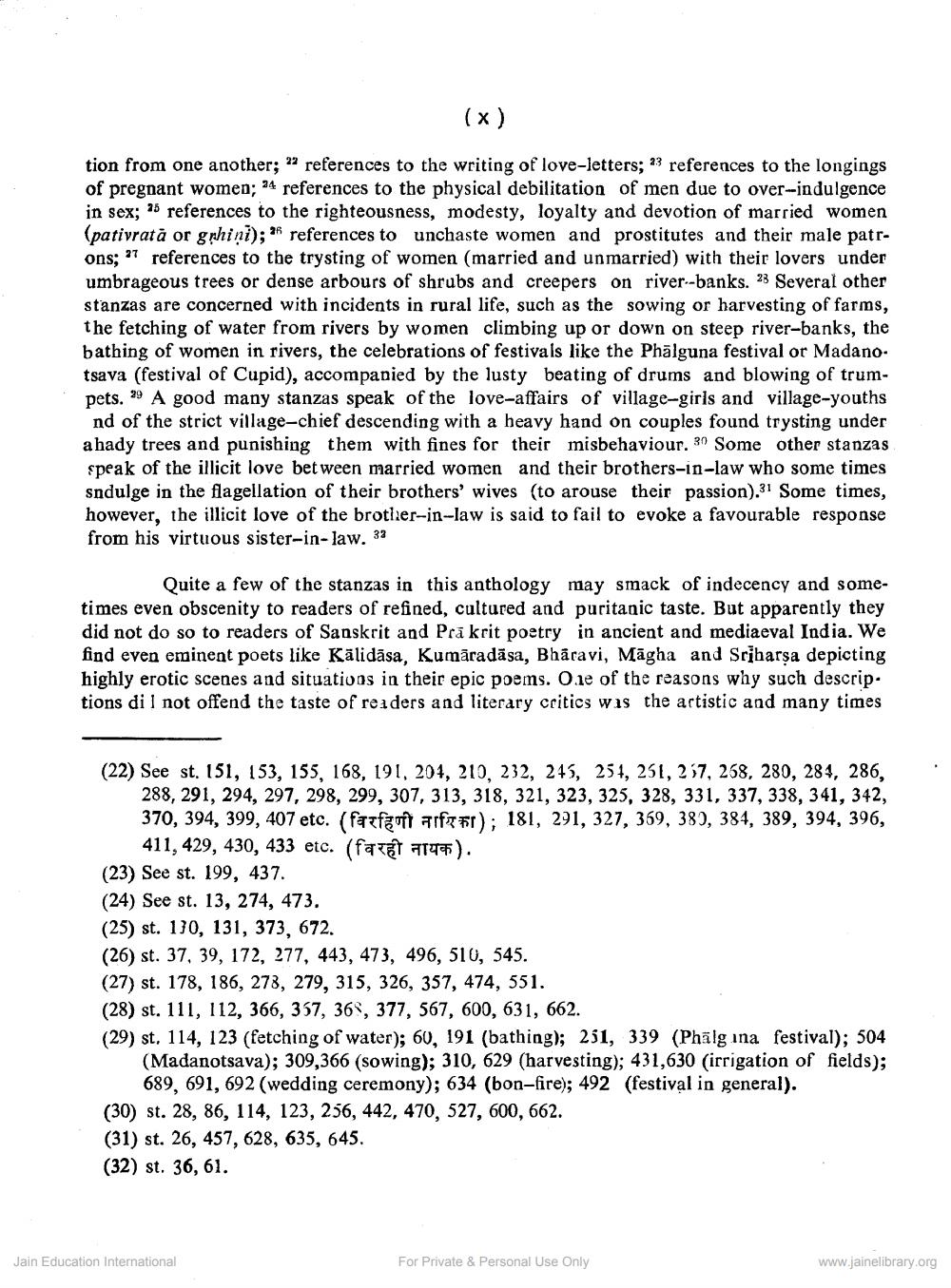________________
(x)
tion from one another; a references to the writing of love-letters; 23 references to the longings of pregnant women; 24 references to the physical debilitation of men due to over--indulgence in sex; as references to the righteousness, modesty, loyalty and devotion of married women (pativrată or gphini); * references to unchaste women and prostitutes and their male patrons; "7 references to the trysting of women (married and unmarried) with their lovers under umbrageous trees or dense arbours of shrubs and creepers on river--banks. 23 Several other stanzas are concerned with incidents in rural life, such as the sowing or harvesting of farms, the fetching of water from rivers by women climbing up or down on steep river-banks, the bathing of women in rivers, the celebrations of festivals like the Phālguna festival or Madano. tsava (festival of Cupid), accompanied by the lusty beating of drums and blowing of trumpets. 29 A good many stanzas speak of the love-affairs of village-girls and village-youths
nd of the strict village-chief descending with a heavy hand on couples found trysting under a hady trees and punishing them with fines for their misbehaviour. 39 Some other stanzas speak of the illicit love between married women and their brothers-in-law who some times sndulge in the flagellation of their brothers' wives (to arouse their passion).31 Some times, however, the illicit love of the brother-in-law is said to fail to evoke a favourable response from his virtuous sister-in-law. 32
Quite a few of the stanzas in this anthology may smack of indecency and sometimes even obscenity to readers of refined, cultured and puritanic taste. But apparently they did not do so to readers of Sanskrit and Prakrit poetry in ancient and mediaeval India. We find even eminent poets like Kālidāsa, Kumāradāsa, Bharavi, Māgha and Sriharsa depicting highly erotic scenes and situations in their epic poems. One of the reasons why such descrip. tions di I not offend the taste of readers and literary critics was the artistic and many times
(22) See st. 151, 153, 155, 168, 191, 204, 210, 232, 245, 251, 251, 257, 258, 280, 284, 286,
288, 291, 294, 297, 298, 299, 307, 313, 318, 321, 323, 325, 328, 331, 337, 338, 341, 342, 370, 394, 399, 407 etc. (fazfart aftFl); 181, 291, 327, 359, 382, 384, 389, 394, 396,
411, 429, 430, 433 etc. (fata ath). (23) See st. 199, 437. (24) See st. 13, 274, 473. (25) st. 130, 131, 373, 672. (26) st. 37, 39, 172, 277, 443, 473, 496, 510, 545. (27) st. 178, 186, 278, 279, 315, 326, 357, 474, 551. (28) st. 111, 112, 366, 357, 36, 377, 567, 600, 631, 662. (29) st, 114, 123 (fetching of water); 60, 191 (bathing); 231, 339 (Phālg ina festival); 504
(Madanotsava); 309,366 (sowing); 310, 629 (harvesting); 431,630 (irrigation of fields);
689, 691, 692 (wedding ceremony); 634 (bon-fire); 492 (festival in general). (30) st. 28, 86, 114, 123, 256, 442, 470, 527, 600, 662. (31) st. 26, 457, 628, 635, 645. (32) st. 36, 61.
Jain Education International
For Private & Personal Use Only
www.jainelibrary.org




